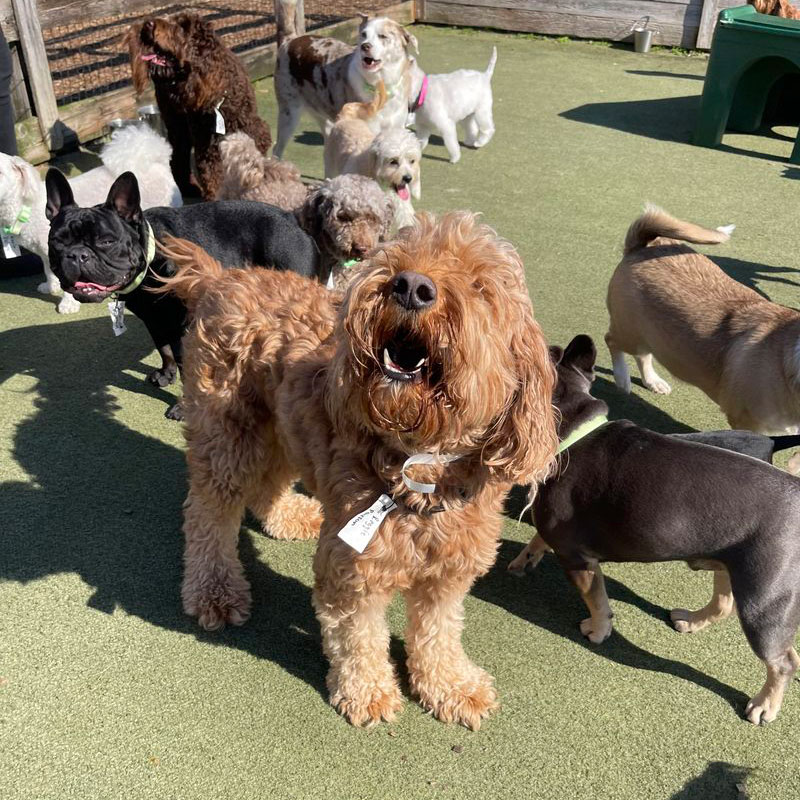How to Calm Your Dog’s Barking with Tips from Our Trainer

How to Calm Your Dog’s Barking with Tips from Our Trainer
Picture this: You’re at a dog-friendly park with your pup. Everyone around you is enjoying the stunning views, the sweet sounds of birds chirping, and the precious time spent with their loved ones. You’re taking it all in and loving the serenity of it all when your fur-baby starts barking up a storm. It quickly becomes clear that a frolicsome squirrel is the reason for this sudden outburst, so you know there’s nothing to worry about. But what you don’t know is how to help your four-legged bestie quiet down.
What can I do to calm my dog’s barking?
Seeing a squirrel or other small critter is just one of the many reasons why your dog may bark, and it’s important to remember that barking is their main way of communicating with you. Just as you may call up your friends when you need to talk through something, your canine companion barks, woofs, and howls to share their emotions, wants, and needs with you, so you shouldn’t try to stop your pooch from barking entirely.
Still, there are definitely times when you want or need them to be a little less vocal—like when you’re taking an early morning walk in a quiet neighborhood, your pooch spots a group of runners taking an evening jog, or you’ve just settled in with the hopes of enjoying a zen night at home. So, we asked our skilled professional dog trainer Davyda DeSimone to share some useful tips for calming your dog’s barking. Here’s what she said.
Tip #1: “Keep your own voice at a low volume.”
There’s a pretty good chance that if you raise your voice at your dog when you want them to stop barking, it will do more harm than good. Your pup could be talking a mile a minute to let you know they’re excited or that there’s an “intruder” nearby (even if it’s just a pesky squirrel), so raising your voice might confuse them by making them think what they’re doing or feeling is wrong. Matching their volume might even make them bark more because they could think you’re trying to join in on the ruckus.
Tip #2: “Distract your pup from whatever is making them bark.”
Sometimes what your fur-baby needs to help them quiet down is simply having something else to focus on. For example, if you see folks—furry or otherwise—heading toward you while you’re on a walk and your dog decides to say hello by letting out some woofs, you can try calling their name so they look at you instead, turning down a less populated street so the others are out of sight, or giving them something to sniff, like a yummy treat. Similarly, if your dog is barking at something or someone outside the living room window, you could create a sight barrier by closing the curtains or shades, bring your dog to another room, or encourage them to play with a favorite toy. If your dog becomes preoccupied with something else, they will probably quickly forget about whatever it is that was making them bark in the first place.
Tip #3: “Develop a solid and consistent routine with your pup.”
Creating—and sticking to—a daily routine with Fido will help them know exactly what to expect throughout the day. For example, you could try going on a 20-minute walk at the same time each morning, having playtime with them every day when you get home from work, or serving them dinner at the same time each night. If they feel confident that these activities are on the day’s agenda, it may keep them from feeling like they need to bark to ask for things like food, play, or walks.
Tip #4: “Give your dog different ways of communicating their wants and needs.”
If your goal is to get your pooch to bark less, it’s important to teach them different ways of telling you what they want. For example, you could try teaching them to ring a bell attached to the doorknob when they want to go outside to play or relieve themselves. Another option is to introduce your dog to pet communication buttons. When pressed, these buttons will say various words or phrases such as “play,” “walkies,” “outside,” or “treat.” Training your dog to activate these buttons when they want or need something should lead to reduced barks and howls.
At Wagsworth, our experienced staff of trainers can help calm the woofs.
Thank you to Davyda for sharing these helpful tips with our lovely pet-parent community. Though we’re sure her advice will be helpful as you work on your dog’s training at home, we also know that some dogs need a little extra guidance figuring out when it’s an appropriate time to bark and when it’s not. That’s where Wagsworth’s training classes come in.
You can enroll your puppy in a class led by Davyda starting when they’re just 10 weeks old. By the end of the class, they’ll have learned to recognize certain cues—including some that can help reduce barking, like “come” when you want to divert your pooch’s attention—along with basic manners, how to walk on a leash, and so much more. When you and your dog improve your communication skills and learn to understand each other better, it will only make your relationship stronger.
